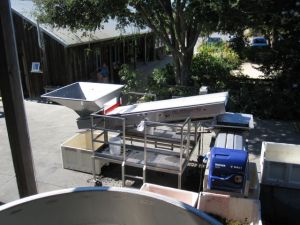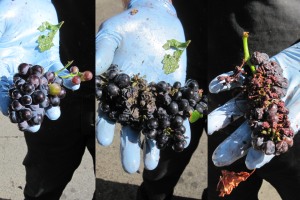
Once organized, these grapes will be visually inspected and sorted on a large conveyor belt. Bins are dumped on to the sorting table and we pull out any “Matter Other than Grapes”; leaves, twigs, rocks, frogs, crickets, dragonflies, clusters shriveled into raisin, second crop (latter blooming fruit that is unripe), and clusters infected by botrytis (noble rot). Each block of fruit, and sometimes each bin varies in how clean they are. Well farmed vineyards, with good picking crews, offer clean lots, and we let most of the grapes pass with only a few things to pick out. Some lots can be from problem areas, so infected by rot, with grapes so dehydrated as to resemble clods of gray dirt, that the speed of the conveyor must drops to a crawl so that we have time to pick it all out.

While at the sorting table, I asked the assistant winemaker about the quality of the fruit we were sorting, and weather is might deserve a vineyard designate wine. His answer was that he didn’t know. Perhaps, but that could only be determined once it was wine, and of course, the wine would have to be distinctive enough to merit being held apart. This is why, the most important step in the whole process of winemaking is probably keeping individual lots separate and organized. Later in the year, the winemakers will sit down and taste and analyze and give thought to what belongs where, blended or set apart. But by fermenting them separately, they are taking part in a long, slow experiment to determine the characteristics of a vineyard, or a portion of a vineyard.
Our pace is determined by the type of fermenter (open or closed top) we will use for that lot. For open top fermenters, which will require punch-downs (to extract color and flavor from the skins), we dump the fruit directly into the tank from the bin, using the forklift. This means we have to change out bins and wait for forklift drivers. With closed top fermenters, we attach a must pump that continually drives the juice and berries into a tank. This leads to faster sorting, but tunnel vision ensues. And when I close my eyes at night, all I can see is grapes, passing by me, and my muscles strain to grab at the leaves and unripe clusters.
By the noon, after sorting for over 4 hours, the table is sticky from sugary grape juice, and I as well am covered with sticky juice, up to my elbows. The front of my pants, covered in juice has collected twigs and leaves. We must hose down the table and bins and de-stemmer before we break for lunch, lest the juice dries out, leaving an near impossible cleaning task for the end of the day. Even so, after another four hours of sorting in the afternoon, the equipment is covered in a layer of sugar and tartaric acid that has built up and needs to be pressure washed off.
No comments:
Post a Comment